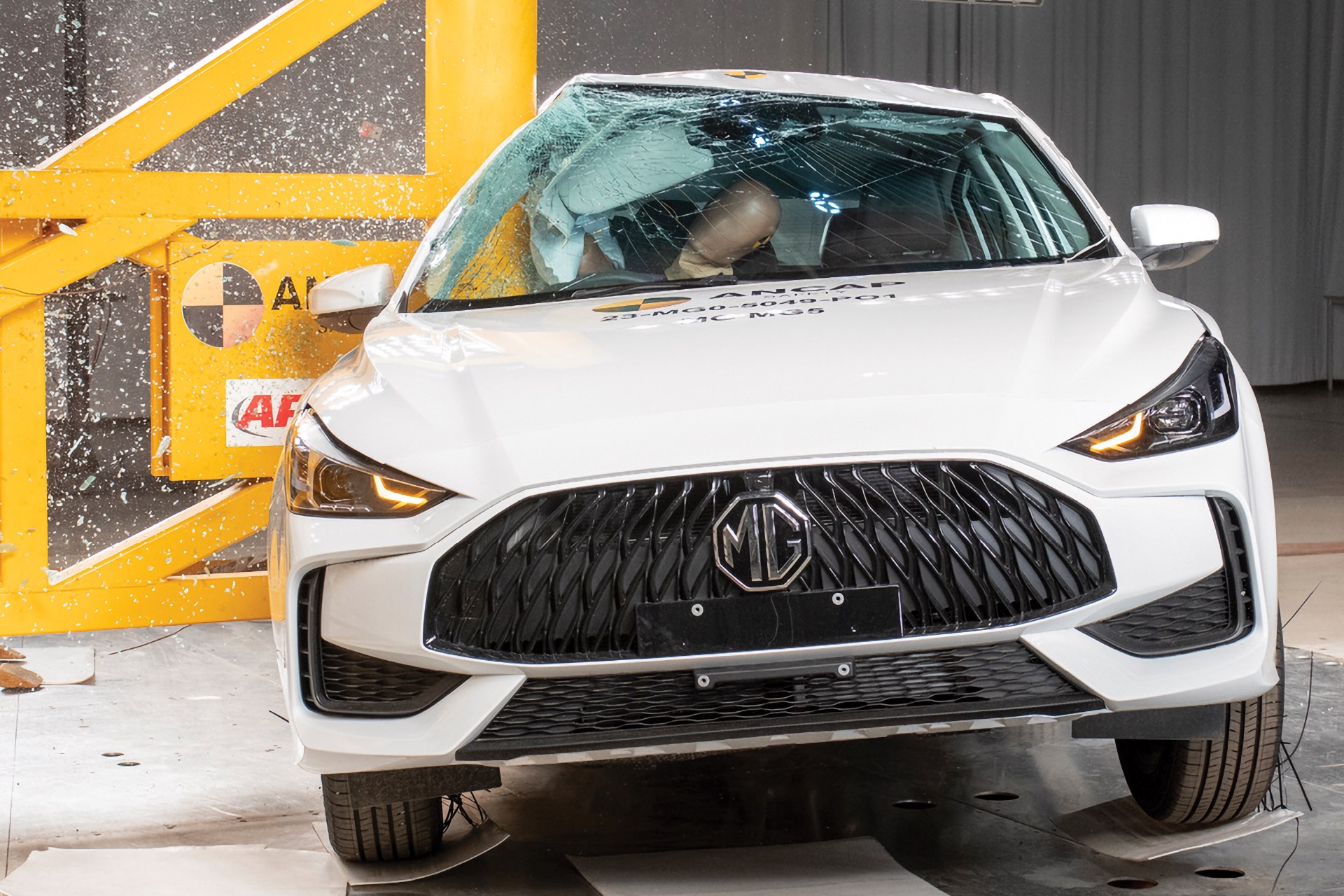ANCAP has issued a zero-star rating to the MG 5 sedan, which was introduced to Australia in August 2023, after performing its own crash tests in Australia. ANCAP said the rating, which applies to all variants, is due to a range of limitations in physical crash protection and active collision avoidance performance.
ADULT OCCUPANT PROTECTION
The passenger compartment of the MG 5 remained stable in the frontal offset (MPDB) test. Protection of the driver’s head was marginal while the driver’s chest deflection exceeded limits and was rated poor. Structures in the dashboard were a potential source of injury for the driver and a penalty was applied. Protection of the upper legs was rated marginal and lower legs was poor. Protection of the front passenger chest and upper and lower legs was adequate, while protection offered to the front passenger head was good.
The front structure of the MG 5 presented a moderate risk to occupants of an oncoming vehicle in the MPDB test (which evaluates vehicle-to-vehicle compatibility), and a 5.46-point penalty (out of eight points) was applied.
In the full width frontal test, protection was marginal for the neck and chest of the driver and good for all other critical body regions. Protection of the neck of the rear passenger was rated adequate, while chest protection was poor as a result of the chest deflection and seat belt loads exceeding injury limits. The pelvis of the rear passenger ‘submarined’ and slipped beneath the lap section of the seatbelt during the FWF test, indicating a risk of abdominal injury, leading to protection of the pelvis area being rated poor.
Dummy readings indicating high chest injury risk were recorded in both frontal crash tests, and scores for these tests were limited to zero under ANCAP’s protocols.
In the side impact test, protection offered to all critical body regions of the driver was good. In the oblique pole test, protection was adequate for the chest of the driver and good for all other critical body regions.
A centre airbag to prevent contact between the heads of front seat occupants in side impacts is not available. Information regarding the prevention of excursion (movement towards the other side of the vehicle) in the far side impact tests was not provided by MG, and no points were awarded.
MG advised that they were unable to supply representative seats for whiplash testing, so no points were awarded for this assessment.
A rescue sheet providing information for first responders in the event of a crash is available.
A multi-collision braking system is not fitted.
It was demonstrated that if the car entered water, the doors of the MG 5 would remain functional, but window opening functionality was not demonstrated.
CHILD OCCUPANT PROTECTION
In the frontal offset test, protection of the head and neck of both the 10-year and six-year dummies, along with the chest of the 10-year dummy, were weak. Protection of the six-year dummy chest was good.
In the side impact test, protection of the six-year dummy’s head was weak and the 10-year dummy was adequate.
Protection of other key body regions of the six-year and 10-year child dummies was good.
The MG 5 is fitted with lower ISOFix anchorages on the rear outboard seats and top tether anchorages for all rear seating positions.
A child presence detection (CPD) system, which provides an alert when a child has been left in the vehicle, is not available.
Most child restraints could be accommodated in most rear seating positions, though one of the selected Type A convertible seats in rearward facing mode and the Type E booster could not be correctly installed in the centre rear position.
VULNERABLE ROAD USER PROTECTION
The bonnet of the MG 5 provided mostly adequate or marginal protection to the head of a struck pedestrian, while weak and poor results were recorded at the rear of the bonnet, at the base of the windscreen, and on the stiff windscreen pillars.
Protection of the pelvis was good at all test locations. Protection of the femurs and lower legs was mixed, with most areas assessed as marginal to poor.
The MG 5 is fitted with an autonomous emergency braking (AEB) system with “extremely limited” ability to recognise and react to pedestrians. Testing of this system showed marginal performance in pedestrian test scenarios, with collisions avoided or mitigated in most daytime scenarios but only very limited performance in night-time scenarios.
No performance was recorded when the vehicle is turning (pedestrian crossing a side road).
The AEB system, which is capable of functioning at highway speeds, does not react to vulnerable road users in reverse (AEB back over), and these tests were not conducted.
Weak performance was recorded in AEB cyclist test scenarios with little or no mitigation observed in the tested scenarios. There is no system to prevent or mitigate impacts with a passing bicycle (cyclist dooring).
Good performance was seen in the forward motorcyclist AEB tests, but the system does not respond to a motorcycle in the turning or overtaking test scenarios.
SAFETY ASSIST
Lane support, blind spot monitoring and driver monitoring systems, as well as a speed limit information function, are unavailable. A seatbelt reminder system is fitted to the front seating positions only.
Tests of the AEB car-to-car system showed marginal performance with collisions avoided at most lower speeds, and with impact speeds reduced in higher speed tests. However, no points were awarded for ‘driving towards a stationary car’ test scenarios as performance prerequisites were not met (front whiplash performance tests not conducted). The AEB system does not react to junction (turn across path or crossing) scenarios.

